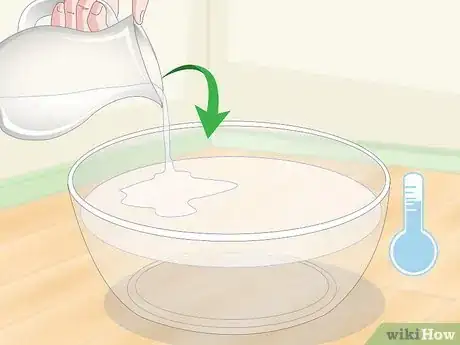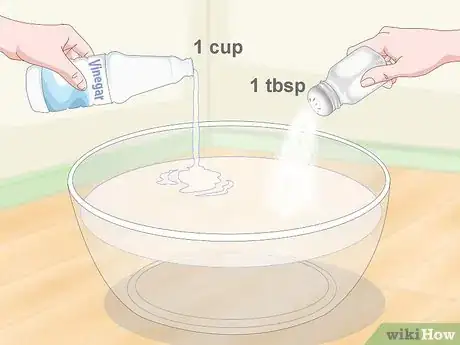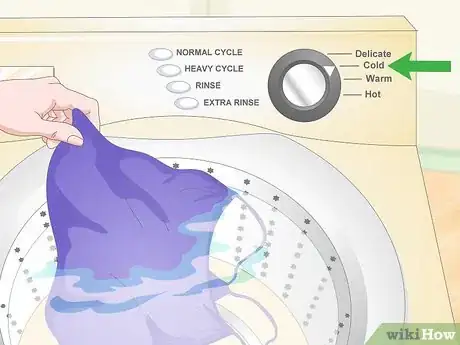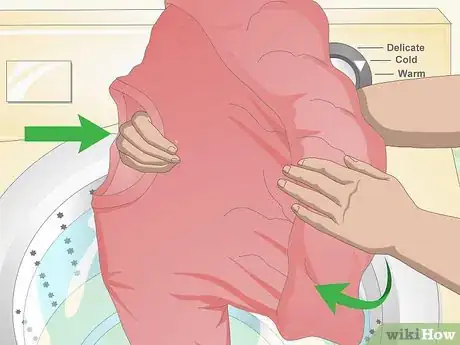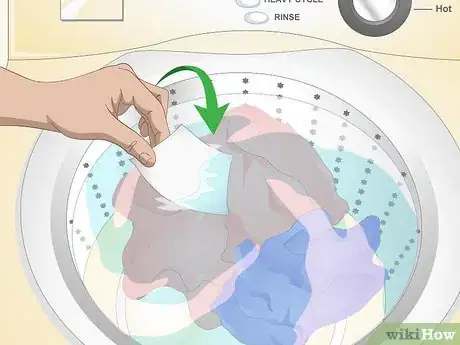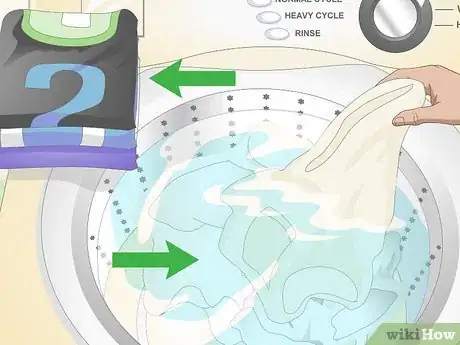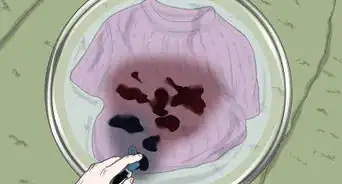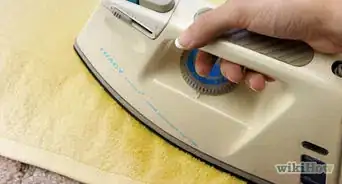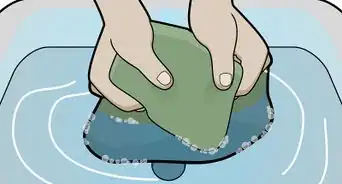This article was co-authored by wikiHow Staff. Our trained team of editors and researchers validate articles for accuracy and comprehensiveness. wikiHow's Content Management Team carefully monitors the work from our editorial staff to ensure that each article is backed by trusted research and meets our high quality standards.
There are 8 references cited in this article, which can be found at the bottom of the page.
This article has been viewed 99,684 times.
Learn more...
Dyeing fabric is a great way to give it a new look! To keep your store-bought fabric, hand-dyed, or tie-dyed fabrics looking its best, use a vinegar and salt solution to set the dye in place. Prevent the dye from bleeding by washing your fabric on a cold, gentle cycle with colour sheets. These steps help to prolong the life of the fabric and keep the dye looking its best.
Steps
Setting Dye with Vinegar
-
1Fill a bowl or a bucket with cold water. Choose a bowl or bucket that is large enough to fit your dyed fabric in. Then, fill the container 5 centimetres (2.0 in) from the top with cold water. It is important to leave this gap, as it prevents the water from overflowing when you add the fabric.[1]
- This method works on all dye colours and can be used for all types of fabric, including denim, cotton, wool, and linen.
-
2Stir in 1 c (8.0 fl oz) of white vinegar and 1 tbsp (17.5 g) of salt. Measure the vinegar and salt into the water. Use your hand or a wooden spoon to mix the solution until the salt dissolves. The vinegar and salt helps to fix the dye into the fibres of the fabric.[2]
- Avoid using malt or apple cider vinegar instead of white vinegar, as these don’t have the same fixing properties.
Advertisement -
3Submerge the dyed fabric in the vinegar solution for 1 hour. Place the dyed item into the solution and use your hand to push it completely under the water. Move the item around a little to remove any air pockets from around the fabric. Leave the item to soak to give the solution time to absorb into the fibres of the fabric.[3]
- Place the bucket away from pets or children to avoid it getting accidentally knocked over.
-
4Hold the fabric under a cold tap to rinse off the vinegar solution. Lift the item out of the bucket and hold it under the tap. Leave the fabric under the running tap for about 1 minute to allow the water pressure to push the vinegar solution out of the fibres.[4]
- Avoid rinsing the fabric under hot water, as this can cause the dye to bleed.
-
5Place the fabric in the washing machine on a cold cycle by itself. Add your usual washing powder or liquid into the machine and then put in your dyed fabric. Set the cycle to the coldest setting and press start. Avoid washing other items with the fabric, as this can cause bleeding.[5]
- If you are washing a delicate fabric, such as wool or silk, set the machine to a delicate or gentle cycle.
- Dry the fabric in a dryer or leave to air-dry.
Preventing Bleeding
-
1Wash your dyed fabrics in cold water on a gentle cycle. Never place your dyed fabric in hot water or on a hot washing cycle, as this opens up the fibres in the fabric and allows the dye to escape. Place the machine on a gentle cycle to reduce friction and prevent bleeding.[6]
- Use a cold-wash washing powder for optimal cleaning power.
-
2Turn your garments inside-out to prevent fading. Over time, the friction of machine washing causes the dye to seep out of the fabric. If possible, turn your garment inside out. If you can’t turn the item inside out, ensure that the washing machine is set to a gentle cycle to minimise fading.[7]
-
3Avoid over-filling your washing machine. The more items that you put in your washing machine, the greater the friction on the fibres. Limit the number of items in each load of washing to maintain the colour of the dye in the fabric.[8]
- Look inside the barrel of your washing machine to locate the maximum load line.
- Similarly, avoid over-filling your dryer to prevent bleeding.
-
4Add a colour-catching sheet to your wash to prevent bleeding. These sheets help to absorb any dye pigments in the water which helps to prevent bleeding and staining. Place 1 colour-catching sheet in a small or regular load of washing or 2 sheets in a large load.[9]
- Purchase colour-catching sheets from a grocery shop or a department store.
-
5Separate light and dark colours when washing to avoid stains. This is ensures that even if there is a small amount of bleeding, nothing will get ruined. Wash white fabrics by themselves, light colours in another load, and dark colours on a separate cycle.[10]
- It safe to dry different colours together.
Things You’ll Need
- Bowl or bucket
- 1 c (8.0 fl oz) of white vinegar
- 1 tbsp (17.5 g) of salt
- Washing powder or liquid
References
- ↑ https://youtu.be/IO7awsFZ6fA?t=58
- ↑ https://youtu.be/IO7awsFZ6fA?t=29
- ↑ https://youtu.be/IO7awsFZ6fA?t=66
- ↑ https://youtu.be/IO7awsFZ6fA?t=138
- ↑ https://www.favecrafts.com/Tie-Dye/How-to-Set-Tie-Dye-in-Fabric
- ↑ https://youtu.be/IO7awsFZ6fA?t=95
- ↑ https://speedqueen.com/the-secrets-to-stopping-colors-from-bleeding-and-fading/
- ↑ https://speedqueen.com/the-secrets-to-stopping-colors-from-bleeding-and-fading/
- ↑ https://speedqueen.com/the-secrets-to-stopping-colors-from-bleeding-and-fading/
